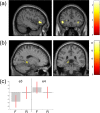Mid age APOE ε4 carriers show memory-related functional differences and disrupted structure-function relationships in hippocampal regions
- PMID: 32080211
- PMCID: PMC7033211
- DOI: 10.1038/s41598-020-59272-0
Mid age APOE ε4 carriers show memory-related functional differences and disrupted structure-function relationships in hippocampal regions
Abstract
Carriers of the APOE e4 allele are at higher risk of age-related cognitive decline and Alzheimer's disease (AD). The underlying neural mechanisms are uncertain, but genotype differences in medial temporal lobe (MTL) functional activity and structure at mid-age might contribute. We tested 16 non-e4 and 16 e4 carriers (aged 45-55) on a subsequent memory task in conjunction with MRI to assess how hippocampal volume (from T1 structural) and microstructure (neurite orientation-dispersion, from NODDI) differs by genotype and in relation to memory encoding. No previous study has investigated APOE effects on hippocampal microstructure using NODDI. Recall performance did not differ by genotype. A genotype by condition interaction in left parahippocampus indicated that in e4 carriers activity did not differentiate subsequently remembered from forgotten words. Hippocampal volumes and microstructure also did not differ by genotype but hippocampal volumes correlated positively with recognition performance in non-e4 carriers only. Similarly, greater hippocampal neurite orientation-dispersion was linked to better recall but only in non-e4s. Thus, we suggest that mid-age e4 carriers show a breakdown of normal MTL activation and structure-performance relationships. This could reflect an inability to utilise compensatory mechanisms, and contribute to higher risk of cognitive decline and AD in later life.
Conflict of interest statement
The authors declare no competing interests.
Figures



Similar articles
-
Temporal lobe functional activity and connectivity in young adult APOE varepsilon4 carriers.Alzheimers Dement. 2010 Jul;6(4):303-11. doi: 10.1016/j.jalz.2009.07.003. Epub 2009 Sep 9. Alzheimers Dement. 2010. PMID: 19744893 Free PMC article.
-
Apolipoprotein E ε4 Modulates Cognitive Profiles, Hippocampal Volume, and Resting-State Functional Connectivity in Alzheimer's Disease.J Alzheimers Dis. 2015;45(3):781-95. doi: 10.3233/JAD-142556. J Alzheimers Dis. 2015. PMID: 25624419
-
Disrupted neural activity patterns to novelty and effort in young adult APOE-e4 carriers performing a subsequent memory task.Brain Behav. 2017 Jan 5;7(2):e00612. doi: 10.1002/brb3.612. eCollection 2017 Feb. Brain Behav. 2017. PMID: 28239522 Free PMC article.
-
The relationship between the apolipoprotein E e4 allele and hippocampal magnetic resonance imaging volume in community-dwelling individuals with mild Alzheimer's disease.Degener Neurol Neuromuscul Dis. 2013 Mar 2;3:11-14. doi: 10.2147/DNND.S40835. eCollection 2013. Degener Neurol Neuromuscul Dis. 2013. PMID: 30890889 Free PMC article. Review.
-
Apolipoprotein E Genotype Moderation of the Association Between Physical Activity and Brain Health. A Systematic Review and Meta-Analysis.Front Aging Neurosci. 2022 Jan 28;13:815439. doi: 10.3389/fnagi.2021.815439. eCollection 2021. Front Aging Neurosci. 2022. PMID: 35153725 Free PMC article.
Cited by
-
APOE ε4-Allele in Middle-Aged and Older Autistic Adults: Associations with Verbal Learning and Memory.Int J Mol Sci. 2023 Nov 5;24(21):15988. doi: 10.3390/ijms242115988. Int J Mol Sci. 2023. PMID: 37958971 Free PMC article.
-
Abnormal percent amplitude of fluctuation changes in patients with monocular blindness: A resting-state functional magnetic resonance imaging study.Front Psychiatry. 2022 Oct 24;13:942905. doi: 10.3389/fpsyt.2022.942905. eCollection 2022. Front Psychiatry. 2022. PMID: 36353573 Free PMC article.
-
A Review of the Current Status of Disease-Modifying Therapies and Prevention of Alzheimer's Disease.Med Sci Monit. 2024 May 13;30:e945091. doi: 10.12659/MSM.945091. Med Sci Monit. 2024. PMID: 38736218 Free PMC article. Review.
-
Neurite dispersion and density mediates the relationship between cardiorespiratory fitness and cognition in healthy younger adults.Neuropsychologia. 2022 May 3;169:108207. doi: 10.1016/j.neuropsychologia.2022.108207. Epub 2022 Mar 5. Neuropsychologia. 2022. PMID: 35259402 Free PMC article.
-
Cognitive implications of white matter microstructural changes in individuals with low heart rate variability: a NODDI study.Front Neurol. 2025 May 9;16:1503599. doi: 10.3389/fneur.2025.1503599. eCollection 2025. Front Neurol. 2025. PMID: 40417123 Free PMC article.
References
Publication types
MeSH terms
Substances
Grants and funding
LinkOut - more resources
Full Text Sources
Medical
Miscellaneous

